Puzzle 1855 was the first reaction design puzzle.
The images below show examples of defining new ligands using the Reaction Design panel.
Starting ligand[]
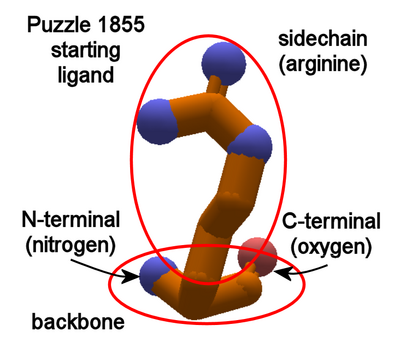
The starting ligand in puzzle 1855 was an arginine molecule, not attached to any other amino acids.
Pulled out of the surrounding protein, the starting ligand in puzzle 1855 is arginine, an amino acid. The N terminal and the C terminal of the arginine are the "linking atoms" where the other reactants will attach.
In the reaction design panel, the linking atoms of the base ligand and the additional reactants appear as black spheres.
(The starting ligand is also referred to as the "base ligand", but "base" is not referring to pH in this case, although arginine's sidechain is the most basic of the 20 amino acids seen in Foldit.)
Reaction Design panel[]

The Reaction Design panel. The first option in each column is automatically selected each time the panel is opened. The ghostly blue preview image shows the shape of a new ligand based on the current selections. The preview is shown over the current ligand.
Opening the Reaction Design panel selects the base ligand and the reactants which attach to it.
In puzzle 1855, there's only a single base ligand, the selected from the row at the top.
The amino acid base ligand offers two "linking atoms", so there are two additional reactants available. The additional reactants can be selected in the left and center columns of the Reaction Design panel.

The options available in the puzzle 1855 reaction panel.
The third column, on the right, allows selecting the "chirality" of the base ligand. The two options are mirror images, L-arginine or D-arginine, left- or right-handed isomers of each other.
When the Reaction Design panel is open, the proposed new ligand is shown as a blue outline, "glowing" with blue highlights.
Clicking the unlabelled test tubes-and-beaker icon applies the selection and makes the new ligand available in the puzzle.
View Options[]
The images below use the original interface, the "hydro" color option, and the "cartoon thin" view option. For "View Hydrogens", the "Hide All H" option is selected. For "View Sidechains", the "Don't Show (Fast)" option is selected. Most of the other view options are deselected, but "View Bonds (Sidechain)" and "Show Bondable Atoms" are selected.
These view options show the current ligand in green, with red, blue, or purple spheres representing the atoms which can participate in hydrogen bonds.
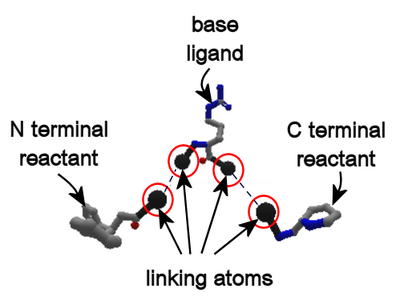
Composite image from puzzle 1855, showing the base ligand and two reactants. The black spheres are the "linking atoms" that will connect the base to the reactants.
Software issues[]
In the initial software release for reaction design, the same default choices are selected each time the panel is opened. The single base ligand is selected in the top row, and the top option of each of the three columns is selected. The same selections appear regardless of any previous changes to the ligand.
In puzzle 1855, using the initial software release, the initial selections on the reaction design panel are not reflected in the preview image. While the top selection in each of the three column is initially highlighted, the preview image shows item 4 from the left column, item 4 from the center column, and item 2 from the right column. The same mismatch between the selections and the preview occurs each time the panel is opened.
In other words, while the selections appear to be "1,1,1" initially, the preview actually shows "4,4,2" when the panel is opened. (Including the base, they could also be called "1,1,1,1", and "1,4,4,2", respectively.)
In the initial software release, the selections in the Reaction Design panel are highlighted with thin blue-gray box, making them hard to see.
In the selection interface, the current ligand must be selected to open the panel. The thick highlighting of the current ligand makes the proposed ligand harder to see. The images on this page use the original interface.
N terminal selection[]

Selecting the third option in the left column changes the appearance of the ligand.
For puzzle 1855, the left column of the reaction design panel selects the reactant to attach to N terminal of the base ligand.
As noted above under "Software Issues", while the first item in the left column is highlighted initially, the preview image shows the fourth item. When you actually click on a selection, the preview image changes to match.
In this example, the third option is selected for the N terminal. The left side of the ligand has changed, but the reactant on the right side remains the same. The reactant on the right side has changed position slightly, however.
C terminal selection[]

The puzzle 1855 ligand with the third options selected for the first two columns.
As noted above under "Software Issues", while the first item in the center column is highlighted initially, the preview image shows the fourth item. When you actually click on a selection, the preview image changes to match.
With option 3 from the left column selected, option 3 from the center column is selected in this example.
Both the left and right sides of the icon have changed at this point.
Chirality option[]

The ligand with the third options from the first two columns selected, along with the second option from the "chirality" column. The ligand appears mostly unchanged from the previous examples.
In puzzle 1855, The column on the right changes the shape of base ligand, the arginine molecule. The options are mirror images of each other, the left-handed and right-handed versions of arginine. Only the left-handed version is used in making proteins, but a ligand can follow different rules.
As noted above under "Software Issues", while the first item in the right column is highlighted initially, the preview image shows the second item. When you actually click on a selection, the preview image changes to match.
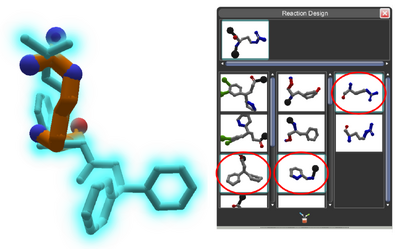
Clicking on the first option in the right column doesn't change its highlighting, but it does change the ligand display. A similar mismatch affects the other two columns.
Accept button[]
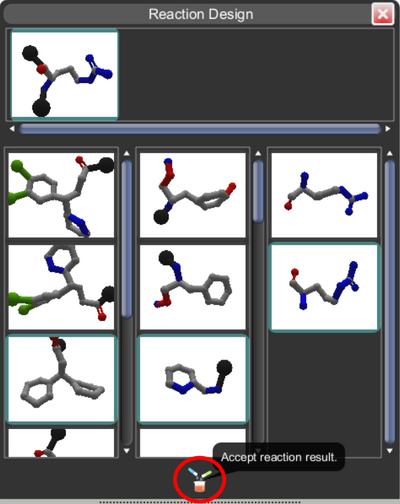
Clicking on the test tubes-and-beaker icon at the bottom of the reaction panel applies the selections to the ligand. Tools like Move, Shake, and Wiggle can be used to refine the resulting design in relation to a protein.
After making the desired selections, clicking on the unlabelled test tubes-and-beaker icon applies the selected options to the ligand.
The position of the new ligand can then be adjusted using the Move tool, and refined using Shake and Wiggle.
The Reaction Panel dialog doesn't have an explicit cancel button. When changing an existing ligand, clicking the red "x" in the upper right corner closes the Reaction Design panel without changing the current ligand.
As always, it's good idea to use the Save Solution dialog or the Open/Share Solutions dialog to save an existing design before making changes.
Quicksave slots can also be used to save solutions temporarily, but their contents may be lost if Foldit crashes. Manual saves are generally more reliable.
Effects of the chirality option[]
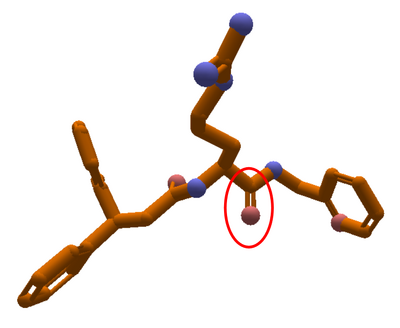
The "3,3,1" version of the puzzle 1855 ligand. Note the position of the circled oxygen atom relative to the nitrogen atom on the left.
For puzzle 1855, the results of making selections in the right column of the reaction design panel were a little confusing.
In the selection interface, the selection highlighting on the existing ligand made it difficult to see how the arginine base ligand changed. Using the original interface is a bit clear, but the existing ligand may partly obscure the new ligand being designed.
The selection highlights are difficult to see, but this is compounded by the apparent mismatch between the initial selection in right column and what's displayed in the glowing blue outline.
For puzzle 1855, one way to tell the chirality of a ligand is to look at the position of the double-bonded oxygen atom (part of the C terminal) in relation to the blue nitrogen atom (the N terminal) of the base ligand.
Using the first chirality selection, the oxygen atom is on the same side of the backbone as the nitrogen atom.
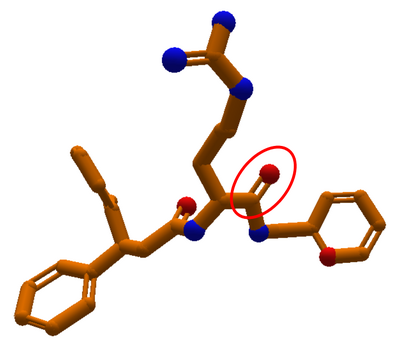
The "3,3,2" version of the ligand. The circled oxygen atom is now on the opposite side of the base ligand's backbone.
Using the third choices for both the left and center columns, the two versions of the ligand shown here could be called "3,3,1" and "3,3,2". These ligands are the same except for chirality.
In the "3,3,2" version of the ligand, the double bonded oxygen atom appears on the opposite side of the backbone from the blue nitrogen atom.
For puzzle 1855, changes made in the Reaction Design panel generally seem to have a minimal effect on the position of the base ligand. Since only a single base ligand is available, that's not too surprising.
It appears that the Reaction Design panel can change the position of the puzzle 1855 base ligand in some cases. Future puzzles may allow selecting from multiple base ligands, so these puzzles may have a disorienting effect on the position of the ligarnd.
Other cases[]
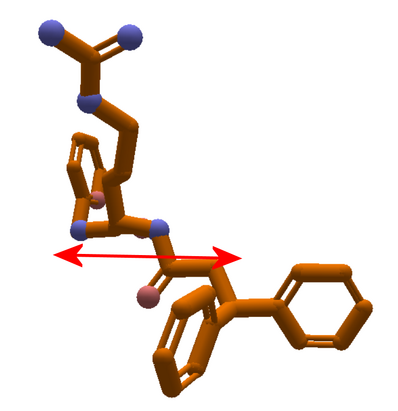
The reactants appear to have been reversed in this version of the ligand. It's not clear why this happens, but it may be a simple rotation of the ligand.
In some cases, the Reaction Design panel in puzzle 1855 seems to assemble the reactants in reverse order.
The example here shows the two pentagonal rings and the single pentagonal ring reversed from the previous examples.
Looking closely at this example, the double-bonded nitrogen at the tip of the arginine has also switched sides. So the ligand in effect may have rotated about 180 degrees horizontally.
It's not clear exactly why this rotation occurs. So far, it's been difficult to reproduce. Normally, any changes to the ligand seem to leave the base arginine very close to its starting position.